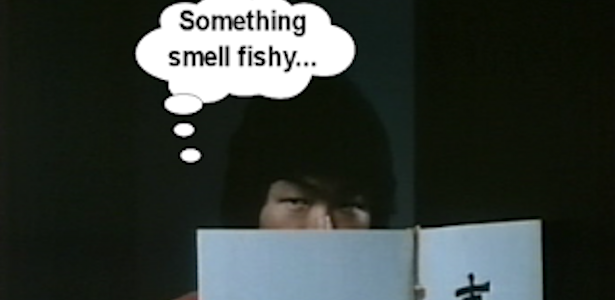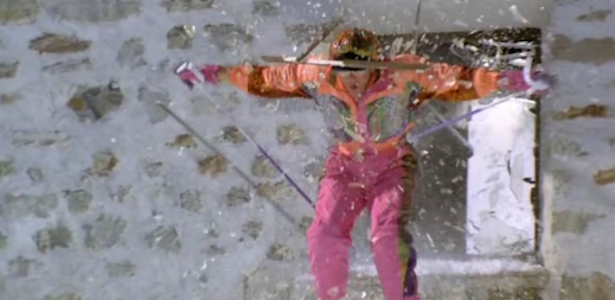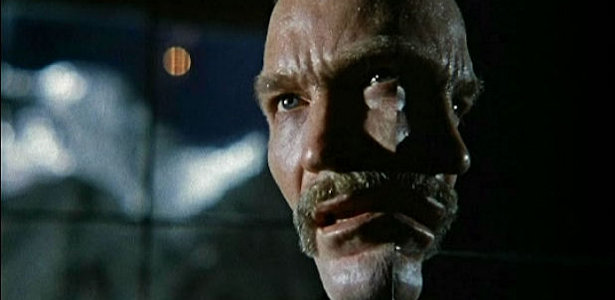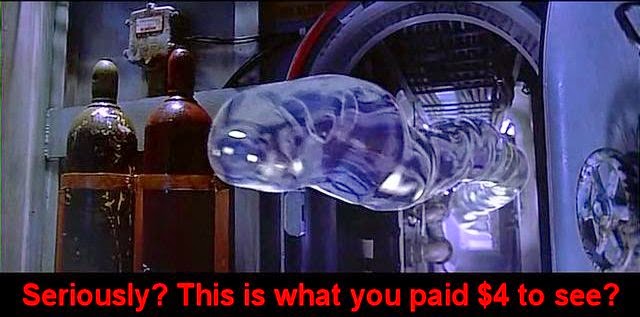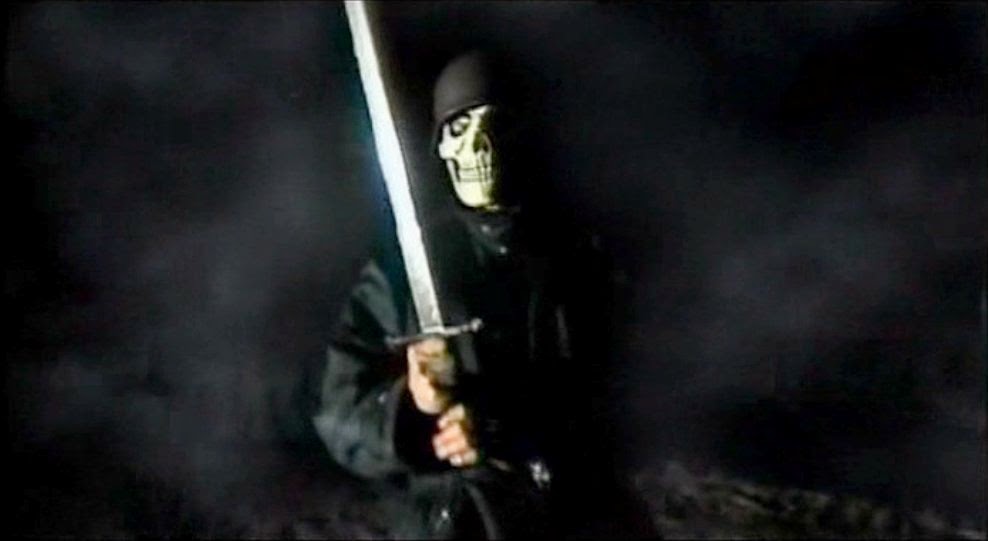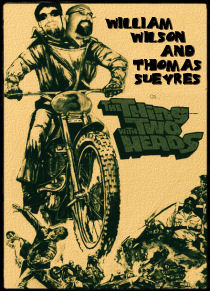Hollywood is like a daycare center. Lots of excessive
mood-swings, temper tantrums and self-indugent behavior in a noisy microcosm of
the real world. The introduction of a virus to the population will run like
wildfire through that microcosm. In Hollywood ideas are viral. People talk,
scripts are read, concepts are pitched and after a while everyone is in love
with the idea, they are not so much so in paying the guy who came up with it.
Thus we get a year or two that are stuffed with movies that have similar
concepts and even completely identical plots and characters.
In the late ‘80s trade papers and movie magazines were
suddenly brimming with info about yet another sub-aquatic genre movie going
into production. DEEPSTAR SIX was the first of the cycle and inspite of being
touted as a new horror film from the creator of FRIDAY THE 13 (I can see Sean
Cunningham coming up with that himself), it quickly sank off the radar in the
January no-man’s-land of 1989. A few short months later another film quickly
surfaced. Behold LEVIATHAN, an entry in a crowded genre (at least for that
year), that to this day is the Rodney Dangerfield of aquatic horror films. No respect at all.
The crew of a sub-oceanic silver mine have only three days
remaining before the end of their 90 day shift. We are told this right upfront,
which is pretty much like introducing a cop who is about to retire. You know
someone is going to have a very bad day.

The crew consists of a diverse group
of miners including a sensitive Latino, DeJesus (Michael Carmine) who is having
trouble with his suit, we know this because his suit has a red, built-in
warning light in the shape of a skull and crossbones that flashes at the wearer
when they are about to run out of oxygen. Aside from the fact that I’m sure
that some engineer thought this would be extremely helpful information, I
really don’t think telling someone that they are about to die because their
oxygen is low will actually help conserve air. It probably would have been a
lot more helpful to have a bright green message saying “everything is fine, there
is nothing to worry about,” but I guess that wouldn’t make for very interesting
cinema. Geologist turned project lead, Beck (Peter Weller), finds that the
burnout Doc (Richard Crenna), is nowhere to be found during this emergency and
also panics, but since it’s Peter Weller, you can’t really tell. Love the guy, but there is a reason he gained fame as an emotionless cyborg police officer.
 |
| Rule #1: Never trust Meg Foster |
Right before some well-deserved down time, Six Pack manages
to fall off of a seacliff into a nest of “sea-worms” (hell if I know). For some
reason in spite of being the sleaziest douchebag to ever work in manual labor,
the crew decides to mount a rescue team. Seriously, his workplace sexual
harassment could put an entire floor of HR reps into cardiac arrest with his
excessive leering, groping, and foul-mouthed shenanigans. Fortunately for him,
the local babage are well practiced in the art of thin-lipped smiles. The rescue team
finds Mr. Pack strolling around in a sunken Russian ship that he stumbled
across, The Leviathan. Once back in aboard the Nostromo – err, I mean the mining
shack, the crew digs into a strongbox that has remained sealed under the sea.
As they discover, the ship has clearly been intentionally
sunk, and the strongbox has some unusual contents including the files of
several deceased crew members and a videotaped captain’s log. Conveniently the
Doc is fluent in Russian and discovers that a virus had spread through the ship
before she sank. Presumably this virus was not a script for an underwater
horror movie. Because there is nothing better than alcohol that has been aged in a pewter, Six Pack manages to sneak a hip flask out of
the contents of the strongbox with only Bowman being the wiser. One can only imagine how much more obnoxious he is after getting a high-pressure buzz going.
 As it turns out, Beck is more of a geologist than a leader
and his difficulty with his crew, including the Doc who could give a rats ass
about pretty much anything, is very well trodden ground, and I don’t just mean
the obvious connection to ALIEN. That said, because of the solid b-list cast,
the build-up never feels strained, Daniel Stern’s scenery chewing
notwithstanding. Speaking of which, Six Pack high-tails it back to his bunk to
knock back the contraband hooch with Bowman who suddenly, like most single folks
realizes that alcohol will blunt the annoyingness
of present company. Sure enough this turns out to be the worst idea since Hitler
invaded Russia, and suddenly Six Pack has come down with a horrible infection
that is causing his skin to break out and become scaly. It isn’t very long
before things take a nasty turn and peeps be mutating faster than you can say
“Who Goes There?”
As it turns out, Beck is more of a geologist than a leader
and his difficulty with his crew, including the Doc who could give a rats ass
about pretty much anything, is very well trodden ground, and I don’t just mean
the obvious connection to ALIEN. That said, because of the solid b-list cast,
the build-up never feels strained, Daniel Stern’s scenery chewing
notwithstanding. Speaking of which, Six Pack high-tails it back to his bunk to
knock back the contraband hooch with Bowman who suddenly, like most single folks
realizes that alcohol will blunt the annoyingness
of present company. Sure enough this turns out to be the worst idea since Hitler
invaded Russia, and suddenly Six Pack has come down with a horrible infection
that is causing his skin to break out and become scaly. It isn’t very long
before things take a nasty turn and peeps be mutating faster than you can say
“Who Goes There?”
Naturally this all leads to a creature stalking the
spaceship-esque corridors and the crew being picked off one by one. Fortunately
the company provided them with some much needed equipment for underwater
mining, like… flamethrowers. I can’t think of anything more useful when
underwater than a flamethrower. Perhaps a screen door, but barring that
flamethrowers will do. Presumably the flamethrowers were needed to toast
marshmallows. Hey, what is more comforting than making s’mores when you are out
in no-man’s land? Gotta keep moral up. The station is also equipped with
hyper-modern chainsaws which would be used for… uhhhh… defending yourself
against any hostile aquatic species that manage to get past the airlock, I
guess. The company must have been planning ahead.
 Back in the day I remember liking Stan Winston’s work, but
feeling that he derived perhaps a bit too much inspiration from H.R. Geiger and
Carlo Rambaldi’s work in ALIEN in nearly every movie he made. Ironically, both of Winston’s top monster men
on LEVIATHAN, Alec Gillis and Tom Woodruff (who also wore the suit), went on
to do the creature effects for the filmed version of ALIEN 3 (1992). This is also a
point of criticism for modern fans; the script is like a cocktail recipe: 2 parts ALIEN, 1 part THE THING
(1982) add a generous splash of seawater and shake vigorously. The creature mutates its victims into an amorphous blob
of parts which can separate and chase after the cast members. It’s pretty
ballsy to filch from a flick that set the bar for latex creatures for decades
to come, and if you are going to do it, you better bring your A game.
Winston’s work is good, but can’t hold a candle to the lower budgeted John
Carpenter film. Also incurring the bizarre wrath of modern fanboys is one of the
other great things that DEEPSTAR SIX lacked; the fetching Amanda Pays of “Max
Headroom” running around in her underwear. Granted not every film can achieve
such greatness, but it is truly appreciated here. Why some trolls have a problem with that I'll never know.
Back in the day I remember liking Stan Winston’s work, but
feeling that he derived perhaps a bit too much inspiration from H.R. Geiger and
Carlo Rambaldi’s work in ALIEN in nearly every movie he made. Ironically, both of Winston’s top monster men
on LEVIATHAN, Alec Gillis and Tom Woodruff (who also wore the suit), went on
to do the creature effects for the filmed version of ALIEN 3 (1992). This is also a
point of criticism for modern fans; the script is like a cocktail recipe: 2 parts ALIEN, 1 part THE THING
(1982) add a generous splash of seawater and shake vigorously. The creature mutates its victims into an amorphous blob
of parts which can separate and chase after the cast members. It’s pretty
ballsy to filch from a flick that set the bar for latex creatures for decades
to come, and if you are going to do it, you better bring your A game.
Winston’s work is good, but can’t hold a candle to the lower budgeted John
Carpenter film. Also incurring the bizarre wrath of modern fanboys is one of the
other great things that DEEPSTAR SIX lacked; the fetching Amanda Pays of “Max
Headroom” running around in her underwear. Granted not every film can achieve
such greatness, but it is truly appreciated here. Why some trolls have a problem with that I'll never know. Rounding out the top-shelf genre crew, Dino De Laurentiis’
cousins Luigi and Aurelio produced the film and brought no shame to the family
name. In addition to hiring two of the best genre screenwriters of the ‘80s, a
cool cast, a top-notch effects crew and a hugely successful action director,
but they also had the smarts to bring on the legendary Ron Cobb (who had worked
on 1979’s ALIEN) to do the production design. Of course Ron Cobb was also hired
by James Cameron to work in the art department as a conceptual designer for THE
ABYSS (1989) which would be released five months after LEVIATHAN. Because of
Cobb’s involvement, we get some of the best looking lived-in, slightly
futuristic sets since Peter Hyams’ gritty science fiction actioner OUTLAND
(1981). Clearly the set designers at Italy’s renowned Cinecitta, where the
interiors were shot, were allowed a free hand as there is detail in every nook
and cranny. From chotchkie's on computer monitors to strange pieces of art in
the back ground, every inch of the sets can stand up to freeze-frame scrutiny.
Rounding out the top-shelf genre crew, Dino De Laurentiis’
cousins Luigi and Aurelio produced the film and brought no shame to the family
name. In addition to hiring two of the best genre screenwriters of the ‘80s, a
cool cast, a top-notch effects crew and a hugely successful action director,
but they also had the smarts to bring on the legendary Ron Cobb (who had worked
on 1979’s ALIEN) to do the production design. Of course Ron Cobb was also hired
by James Cameron to work in the art department as a conceptual designer for THE
ABYSS (1989) which would be released five months after LEVIATHAN. Because of
Cobb’s involvement, we get some of the best looking lived-in, slightly
futuristic sets since Peter Hyams’ gritty science fiction actioner OUTLAND
(1981). Clearly the set designers at Italy’s renowned Cinecitta, where the
interiors were shot, were allowed a free hand as there is detail in every nook
and cranny. From chotchkie's on computer monitors to strange pieces of art in
the back ground, every inch of the sets can stand up to freeze-frame scrutiny. Budgeted at a whopping $24 million, compared to DEEPSTAR
SIX’s paltry $8 million, LEVIATHAN completely mopped the floor with the
competition in every way, except at the box office. Sure it made more money
than SIX (which pulled in just over $8 million) and hit #2 at the box office
for one week, but at just under $16 million in grosses, LEVIATHAN actually took
a serious beating. SIX broke even, but LEVIATHAN, in spite of being the better
of the two films was a major flop. A large part of the reason for this can be
attributed to “ALIEN Rip-off Fatigue” (or “ARF”). In 1989 a massive amount of
genre films lifted plots, characters and most importantly creatures from both ALIEN
(1979) and ALIENS (1986). If you were like me, you thrived on the ALIEN
knock-offs, and less so on the ALIENS ones which became gratingly irksome well
into the new millennium (thank you Guillermo del Toro). Like them or not there
were a massive quantity of these movies clogging videostore shelves and
mainstream movie goers were growing weary of what seemed to them to be endless
rehashes. The other major factor is the “once bitten” factor. This usually
happens with sequels (such as those of the JAWS franchise), but even in general
trends, a real stinker can lead to a disillusioned audience. After DEEPSTAR SIX
bummed on everyone’s high, it was tough to get people back into the theaters
for another round of the same.
Budgeted at a whopping $24 million, compared to DEEPSTAR
SIX’s paltry $8 million, LEVIATHAN completely mopped the floor with the
competition in every way, except at the box office. Sure it made more money
than SIX (which pulled in just over $8 million) and hit #2 at the box office
for one week, but at just under $16 million in grosses, LEVIATHAN actually took
a serious beating. SIX broke even, but LEVIATHAN, in spite of being the better
of the two films was a major flop. A large part of the reason for this can be
attributed to “ALIEN Rip-off Fatigue” (or “ARF”). In 1989 a massive amount of
genre films lifted plots, characters and most importantly creatures from both ALIEN
(1979) and ALIENS (1986). If you were like me, you thrived on the ALIEN
knock-offs, and less so on the ALIENS ones which became gratingly irksome well
into the new millennium (thank you Guillermo del Toro). Like them or not there
were a massive quantity of these movies clogging videostore shelves and
mainstream movie goers were growing weary of what seemed to them to be endless
rehashes. The other major factor is the “once bitten” factor. This usually
happens with sequels (such as those of the JAWS franchise), but even in general
trends, a real stinker can lead to a disillusioned audience. After DEEPSTAR SIX
bummed on everyone’s high, it was tough to get people back into the theaters
for another round of the same.
Derivative, sure, however the sum of its
parts adds up to a fast paced, highly entertaining sub-aquatic monster film
that deserves a lot more respect than it gets.






